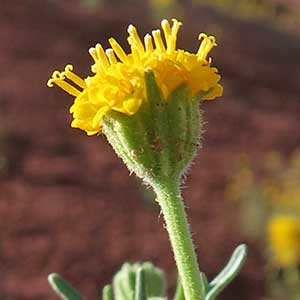Chaenactis nevii
John Day pincushion, John Day's pincushion, Nevius' chaenactis
mostly 1–3;
branches mainly distal.
basal (withering) and cauline, 2–5 cm;
largest blades ± elliptic, ± plane to 3-dimensional, not succulent, 1–2-pinnately lobed;
primary lobes mostly 3–8 pairs, ± remote, ultimate lobes ± plane to involute.
1–6 cm, distally stipitate-glandular and, sometimes, ± arachnoid to villous.
± hemispheric to campanulate.
corollas bright yellow, 4–6.5 mm;
peripheral corollas ± erect, actinomorphic, scarcely enlarged.
longest 6–9 mm;
outer predominantly stipitate-glandular and, sometimes, ± arachnoid to villous in fruit, apices ± erect, acute, rigid.
mostly 3–9 per stem.
3.5–6 mm (compressed);
pappi 0 or coroniform (of ± 10 scales, longest 0.1–0.5 mm).
= 12.
Chaenactis nevii
Chaenactis nevii is known from the John Day Basin area in Gilliam, Grant, Jefferson, Wasco, and Wheeler counties. This odd and isolated species combines traits of C. artemisiifolia (sect. Acarphaea) and C. glabriuscula, and might be descended from their common ancestor.
(Discussion copyrighted by Flora of North America; reprinted with permission.)


